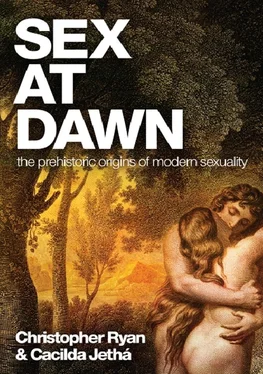Christopher Ryan - Sex at Dawn
Здесь есть возможность читать онлайн «Christopher Ryan - Sex at Dawn» весь текст электронной книги совершенно бесплатно (целиком полную версию без сокращений). В некоторых случаях можно слушать аудио, скачать через торрент в формате fb2 и присутствует краткое содержание. Жанр: Прочая научная литература, на английском языке. Описание произведения, (предисловие) а так же отзывы посетителей доступны на портале библиотеки ЛибКат.
- Название:Sex at Dawn
- Автор:
- Жанр:
- Год:неизвестен
- ISBN:нет данных
- Рейтинг книги:4 / 5. Голосов: 1
-
Избранное:Добавить в избранное
- Отзывы:
-
Ваша оценка:
- 80
- 1
- 2
- 3
- 4
- 5
Sex at Dawn: краткое содержание, описание и аннотация
Предлагаем к чтению аннотацию, описание, краткое содержание или предисловие (зависит от того, что написал сам автор книги «Sex at Dawn»). Если вы не нашли необходимую информацию о книге — напишите в комментариях, мы постараемся отыскать её.
Sex at Dawn — читать онлайн бесплатно полную книгу (весь текст) целиком
Ниже представлен текст книги, разбитый по страницам. Система сохранения места последней прочитанной страницы, позволяет с удобством читать онлайн бесплатно книгу «Sex at Dawn», без необходимости каждый раз заново искать на чём Вы остановились. Поставьте закладку, и сможете в любой момент перейти на страницу, на которой закончили чтение.
Интервал:
Закладка:
1. In A Theory of Moral Sentiments, Smith wrote, “How selfish soever man may be supposed, there are evidently some principles in his nature, which interest him in the fortune of others, and render their happiness necessary to him, though he derives nothing from it, except the pleasure of seeing it.”
2. Gowdy (1998), p. xxiv.
3. From Mill (1874).
4. New York Times, July 23, 2002, “Why We’re So Nice: We’re Wired to Cooperate.” http://www.nytimes.com/2002/07/23/science/
why-we-re-so-nice-we-re-wired-to-cooperate.html. For the original research, see Rilling et al. (2002).
5. We’ve drawn from an excellent analysis of Hardin’s paper by Ian Angus, which can be found at http://links.org.au/node/595.
6. See Ostrom (2009), for example.
8. Harris (1989), pp. 344-345.
9. Bodley (2002), p. 54.
10. Harris (1989), p. 147.
11. van der Merwe (1992), p. 372. Also see Jared Diamond, “The Worst Mistake in the History of the Human Race” (widely available online; see here, for example: http://www.awok.org/worst-mistake/).
12. Le Jeune (1897), pp. 281-283.
13. Gowdy (1998), p. 130.
14. Quoted in Menzel and D’Aluisio, p. 178.
15. Harris (1977), p. x. Also see Eaton, Shostak, and Konner (1988).
16. Gowdy (1998), p. 13.
17. Gowdy (1998), p. 23.
18. Harris (1980), p. 81.
19. Ridley (1996), p. 249.
20. See de Waal (2009) for much more on the biological origins of empathy and instinctive justice.
21. Dawkins (1998), p. 212.
22. de Waal and Johanowicz (1993).
23. Sapolsky and Share (2004). Also see Natalie Angier, “No Time for Bullies: Baboons Retool Their Culture, New York Times, April 13, 2004.
24. Boehm (1999), p. 3, 68.
25. Fromm (1973), p. 60.
26. Gowdy (1998), p. xvii.
1. From his closing argument in the Scopes case.
2. Wade (2006), p. 151.
3. Recent studies of mitochondrial DNA suggest that even before the human migrations out of Africa that began about
60,000 years ago, human populations were largely isolated from each other for as much as 100,000 years, localized in eastern and southern Africa. Only about 40,000 years ago did these two lines reunite, becoming a single pan-African population, according to this research. See Behar et al.
(2008). Full paper available online at http://www.cell.com/AJHG/fulltext/S0002-9297%2808%2900255-3#.
4. Readers interested in further exploration of the critique of Hobbesian assumptions regarding war in prehistory could begin with Fry (2009) and Ferguson (2000).
5. Pinker’s talk was based upon an argument he presents in The Blank Slate (2002), particularly in the last few pages of the third chapter.
6. The link to Pinker’s presentation is http://www.ted.com/index.php/talks/
steven_pinker_on_the_myth_of_violence.html. You can find many other interesting presentations at this site. You might want to search Sue Savage-Rumbaugh’s talks on bonobos, for example. If you prefer to read Pinker’s remarks, an essay based upon the talk can be found at www.edge.org/3rd_culture/pinker07/pinker07_index.html.
7. Note that Pinker’s chart represents part of a chart in Keeley’s book (1996), and that Keeley refers to these societies as “primitive,” “prestate,” and “prehistoric” in his charts (pp. 89-90). Indeed, Keeley distinguishes what he calls “sedentary hunter-gatherers” from true “nomadic hunter-gatherers,” writing, “Low-density, nomadic hunter-gatherers, with their few (and portable) possessions, large territories, and few fixed resources or constructed facilities, had the option of fleeing conflict and raiding parties. At best, the only thing they would lose by such flight was their composure” (p. 31).
As we’ve established, these nomadic (immediate-return) hunter-gatherers are most representative of human prehistory—a period that is, by definition, before the advent of settled communities, cultivated food, domesticated animals, and so on. Keeley’s confusion (and thus, Pinker’s) is largely due to his referring to horticulturalists, with their gardens, domesticated animals, and settled villages, as “sedentary hunter-gatherers” Yes, they do occasionally hunt and they sometimes gather, but because these activities are not their sole source of food, their lives are dissimilar to those of immediate-return hunter-gatherers. Their gardens, settled villages, and so on make territorial defense necessary and fleeing conflict much more problematic than it was for our ancestors. They—unlike true immediate-return foragers—have a lot to lose by simply fleeing aggression.
Keeley acknowledges this crucial difference, writing, “Farmers and sedentary hunter-gatherers had little alternative but to meet force with force or, after injury, to discourage further depredations by taking revenge” (p. 31).
The point bears repeating. If you live a settled life in a stable village, have a labor-expensive shelter, cultivated fields, domesticated animals, and too many possessions to carry easily, you’re not a hunter-gatherer. Prehistoric human beings did not have any of these things, which is, after all, precisely what made them “prehistoric.” Pinker either fails to appreciate this essential point, or simply ignores it.
8. Societies in Pinker’s chart:
The Jivaro cultivate yams, peanuts, sweet manioc, maize, sweet potatoes, peanuts, tuber beans, pumpkins, plantains, tobacco, cotton, Jivaro banana, sugarcane, taro, and yam. They also traditionally domesticate llamas and guinea pigs and later the introduced dog, chicken, and
pig.
The Yanomami are foraging, “slash-and-burn” Yanomami horticulturists. They cultivate plantains, cassava, and bananas.
The Mae Enga grow sweet potatoes, taro, bananas, sugarcane, Pandanus nuts, beans, and Mae Enga various leaf greens, as well as potatoes, maize, and peanuts. They raise pigs, used not only for meat but for important ritualistic celebrations. About 90 percent of the Dani diet is sweet potatoes. They also cultivate banana and D u umD ani cassava. Domestic pigs are important both for currency used in barter and for the celebration of important events. Pig theft is a major cause of conflict.
The Murngin economy was based primarily on fishing, collecting shellfish, hunting, and gathering until the establishment of missions and the gradual introduction of market goods Murngin in the 1930s and 1940s. While hunting and gathering remain important for some groups, motor vehicles, aluminum boats with outboard engines, guns, and other introduced tools have replaced indigenous techniques.
The Huli’s staple food is the sweet potato. Like Huli other groups in Papua New Guinea, the Huli prize domestic pigs for meat and status.
9. This, according to Fry (2009).
10. Knauft (1987 and 2009).
11. To make matters even worse, Pinker juxtaposes these bogus “hunter-gatherer” mortality rates with a tiny bar showing the relatively few war-related deaths of males in twentieth-century United States and Europe. This is misleading in many respects. Perhaps most important, the twentieth century gave birth to “total war” between nations, in which civilians (not just male combatants) were targeted for psychological advantage (Dresden, Hiroshima, Nagasaki ...), so counting only male mortalities is meaningless.
Furthermore, why did Pinker not include the tens of millions who died in some of the most vicious and deadly examples of twentieth-century warfare? In his discussion of “our most peaceful age,” he makes no mention of the Rape of Nanking, the entire Pacific theater of World War II (including the detonation of two nuclear bombs over Japan), the Khmer Rouge and Pol Pot’s killing fields in Cambodia, several consecutive decades-long wars in Vietnam (against the Japanese, French, and Americans), the Chinese revolution and civil war, the India/Pakistan separation and subsequent wars, or the Korean war. None of these many millions are included in his assessment of twentieth-century (male) war fatalities.
Читать дальшеИнтервал:
Закладка:
Похожие книги на «Sex at Dawn»
Представляем Вашему вниманию похожие книги на «Sex at Dawn» списком для выбора. Мы отобрали схожую по названию и смыслу литературу в надежде предоставить читателям больше вариантов отыскать новые, интересные, ещё непрочитанные произведения.
Обсуждение, отзывы о книге «Sex at Dawn» и просто собственные мнения читателей. Оставьте ваши комментарии, напишите, что Вы думаете о произведении, его смысле или главных героях. Укажите что конкретно понравилось, а что нет, и почему Вы так считаете.












